
Hornbeams are hardwood trees in the flowering plant genus Carpinus in the birch family Betulaceae. The 30–40 species occur across much of the temperate regions of the Northern Hemisphere.

Ostrya is a genus of eight to 10 small deciduous trees belonging to the birch family Betulaceae. Common names include hop-hornbeam and hophornbeam. It may also be called ironwood, a name shared with a number of other plants.

The buff arches is a moth of the family Drepanidae. The species was first described by Johann Siegfried Hufnagel in 1766. It is found throughout Europe and is well distributed in the British Isles except the far north of England and all of Scotland.

Hesperia, the branded skippers, is a Holarctic genus in the skippers (Hesperiidae) butterfly family. Most species are endemic to North America, Hesperia comma is widespread throughout the region. H. florinda is endemic to temperate eastern Asia. H. nabokovi is endemic to Hispaniola.
Asteropetes is a monotypic moth genus of the family Noctuidae erected by George Hampson in 1901. Its only species, Asteropetes noctuina, was first described by Arthur Gardiner Butler in 1878. It is found on the Kuriles and in Japan.
Niphonyx is a genus of moths of the family Noctuidae.
Perinaenia is a monotypic moth genus of the family Erebidae erected by Arthur Gardiner Butler in 1878. Its only species, Perinaenia accipiter, was first described by Felder in 1874. It is here provisionally treated as separate from Xestia, though it seems closely related. Its closest living relatives are not resolved and thus the genus' eventual fate depends on how Xestia is treated.

Copablepharon grandis, the pale yellow dune moth, is a moth of the family Noctuidae. The species was first described by Strecker in 1878. It is found in North America from southern Alberta east to south-western Manitoba, the eastern parts of South Dakota, North Dakota and Iowa, west to California and south to southern Arizona, New Mexico and western Texas.
Coenophila opacifrons, the blueberry dart or plain-faced blueberry dart, is a moth of the family Noctuidae. The species was first described by Augustus Radcliffe Grote in 1878. It is found in North America from Labrador and Newfoundland, south to New Jersey, west across the boreal forest to eastern British Columbia, south in the mountains to southern Montana.

Redectis vitrea, the scalloped snout or white-spotted redectis, is a litter moth of the family Erebidae. The species was first described by Augustus Radcliffe Grote in 1878. It is found in the United States from Illinois to south-eastern Massachusetts, south to Texas and Florida.

Hypena humuli, the hop looper or hop vine moth, is a moth of the family Erebidae. The species was first described by Thaddeus William Harris in 1841. It is found from coast to coast in Canada south in the east to Florida and Arkansas in the west to California. It is apparently absent from the south-central states. In Canada it is only absent from Newfoundland and Labrador, Prince Edward Island and the far north.

Chlosyne hoffmanni, or Hoffmann's checkerspot, is a butterfly of the family Nymphalidae that is found in western North America. They range from the Sierra Nevada and Cascade Mountains in the U.S. to Manning Park in British Columbia.
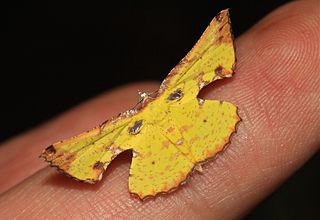
Corymica pryeri is a species of moth of the family Geometridae first described by Arthur Gardiner Butler in 1878. It is found in Japan, Taiwan, the north-eastern Himalayas, Sumatra, Borneo, New Guinea and possibly Queensland, Australia.
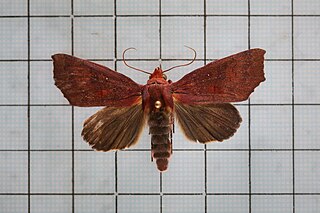
Anomis privata, the hibiscus-leaf caterpillar moth, is a moth of the family Erebidae. The species was first described by Francis Walker in 1865. It is found in China, Taiwan and Japan, but has also been recorded from North America, as most verified sightings have been in the northeastern United States.
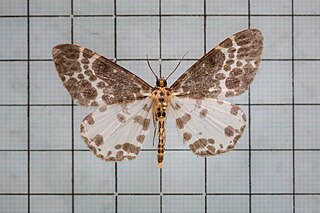
Dilophodes elegans is a moth in the family Geometridae first described by Arthur Gardiner Butler in 1878. It is found in Japan, China, Taiwan, north-eastern Himalaya, Burma and Borneo.
Eupithecia segregata is a moth in the family Geometridae first described by Pearsall in 1910. It is found in the US states of Oregon, Arizona and California.
Pasiphila excisa is a moth in the family Geometridae. It was described by Arthur Gardiner Butler in 1878. It is found in Russia, Japan and Korea.
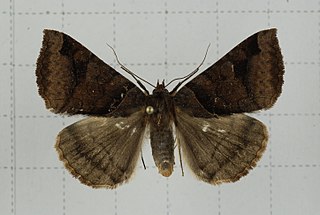
Mocis annetta is a species of moth of the family Erebidae. It is found in Russia, China (Shaanxi), Korea, Taiwan and Japan.
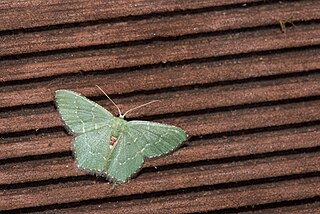
Hemithea marina is a moth of the family Geometridae first described by Arthur Gardiner Butler in 1878. It is found in the Indian subregion, Sri Lanka to Japan, Sundaland, Taiwan, Sulawesi and Seram.
Orthosia segregata is a species of cutworm or dart moth in the family Noctuidae.













